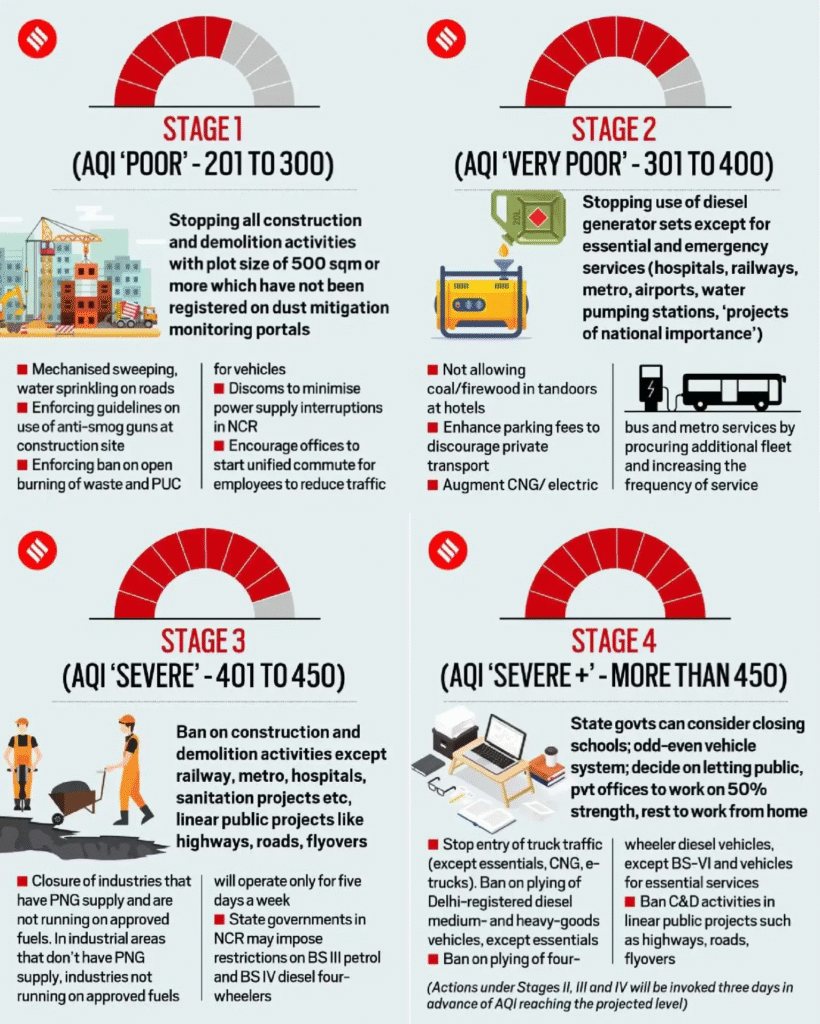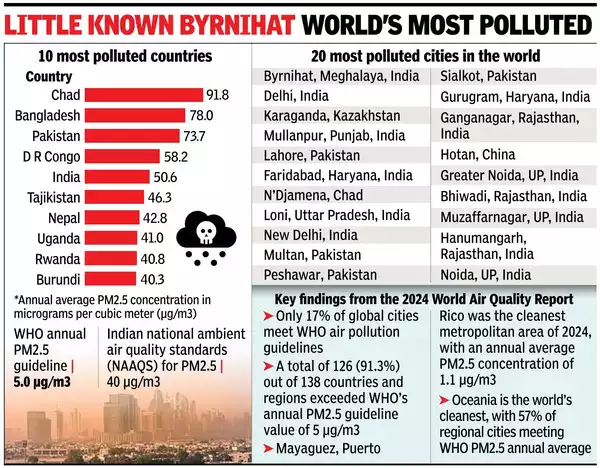Reducing India’s Air Pollution Crisis
Introduction
Delhi experiences significant air pollution every winter as a result of burning crop residue, vehicle emissions, and unfavorable weather that traps pollutants. The Delhi government and IIT Kanpur experimented with cloud seeding in 2025 to create artificial rain, but due to low atmospheric moisture, the operation was not very successful. The experience demonstrated that cloud seeding is a short-term, unreliable solution, highlighting the necessity of long-term, coordinated, and scientifically grounded approaches to address the underlying causes of pollution instead of depending on symbolic interventions.
What are the main causes of India’s escalating air pollution problem?
- Automobile Emissions
- Vehicle emissions are now a significant cause of pollution in India due to the country’s growing motorization. Transportation accounts for more than 30% of all greenhouse gas emissions in Delhi alone. (India’s Major Cities’ GHG Footprint)
- The air quality is greatly deteriorated by vehicles’ emissions of hydrocarbons, carbon monoxide (CO), nitrogen oxides (NOx), and fine particulate matter (PM2.5).
- Vehicle expansion and non-compliance continue to be risks in spite of Bharat Stage VI (BS-VI) requirements (2020).
- Reduced life expectancy, cardiovascular disease, and respiratory problems are all brought on by vehicle pollution.
- Air pollution continues to rank among the top three causes of premature mortality and disability in India, according to the Global Burden of Disease (GBD) 2023 Report.
- The State of Global Air 2024 states that air pollution kills more than two million people in India each year.
- Industrial Pollution
- Sulfur dioxide (SO₂), particulate matter, and nitrogen oxides (NOx) are released by coal-fired power stations, cement factories, and manufacturing facilities.
- Despite the expansion of renewable energy installations, coal continues to be the primary source, producing about 70% of electricity.
- Persistently high pollution loads are caused by major industrial belts in states like Uttar Pradesh and Maharashtra.
- These emissions worsen cardiac and respiratory conditions by causing acid rain and smog.
- Particularly in urban areas, industrial pollution frequently surpasses allowable levels, making wintertime air quality dangerous.
- Due to ineffective State Pollution Control Boards (SPCBs) and monitoring organizations, many projects move forward without conducting adequate Environmental Impact Assessments (EIAs) or ignore clearance requirements.
- Burning Crop Residue
- Every year, millions of tons of smoke and particulate matter are released by the burning of wheat and rice residues across Punjab, Haryana, and Uttar Pradesh.
- The air quality in northern India is drastically worsened by this practice, which peaks in October and November.
- Government incentives for mechanical residue management, such as “Happy Seeder” devices, have not sufficiently addressed the immediate economic and logistical difficulty faced by farmers, which is why the issue still exists.
- Delhi’s AQI rises above 400 as a result of the ensuing smog, leading to respiratory problems, school closures, and financial losses.
- Millions of people are exposed to particulate matter over permissible limits daily, which exacerbates respiratory and cardiac morbidity due to the pollution-NCD relationship.
- Crop burning is still common despite government incentives for automated residue management because of a lack of knowledge and affordable alternatives.
- Road and Construction Dust
- Large amounts of construction dust are produced by India’s urban infrastructure expansion. Road dust is further stirred by unpaved roads and moving cars, which increases PM10 pollution.
- Asthma, bronchitis, and other respiratory conditions are made worse by dust, especially in young people and the elderly.
- In cities like Bengaluru and Delhi, dust can contribute up to 50% of PM10 levels during dry seasons.
- Poor oversight and insufficient enforcement of current regulations of construction dust management and C&D waste disposal are often exhibited by regulatory authorities and ULBs. Fines are frequently insufficient or enforced inconsistently, making them ineffective as a deterrence.
- Poor Handling of Waste
- Urban slums and peri-urban areas frequently burn municipal solid waste—including plastics and electronic waste—outdoors.
- Dioxins, furans, heavy metals, and particulate matter are released as a result.
- releases harmful pollutants that deteriorate soil and air quality, increasing the risk of cancer and chronic illnesses.
- India produces an average of 62 million tonnes (MT) of garbage each year, comprising 7.9 MT of hazardous waste, 5.6 MT of plastic waste, 1.5 MT of e-waste, and 0.17 MT of biological waste, according to a report by The Energy and Resources Institute (TERI).
- Of all the garbage produced, only 43 MT are collected, 12 MT are processed before being disposed of, and the remaining 31 MT are dumped in wasteyards.
- Air pollution in Homes
- Approximately 340 million tonnes of carbon dioxide are released into the atmosphere annually by 41% of Indians who still use wood, cow dung, or other biomass for cooking, accounting for 13% of the country’s total greenhouse gas emissions.
- Both indoors and outdoors, this produces noxious gases and dangerous particles.
- Seventy-five percent of chronic respiratory disorders are caused by chronic obstructive pulmonary disease (COPD), which is closely associated with indoor cooking fuel smoke and urban ambient pollution.
- Geographical and Meteorological Factors
- Pollutants are trapped close to the surface during the winter months due to temperature inversions, low wind speeds, and thick fog.
- Pollutant accumulation is made worse by the flat geography and dense population of the Indo-Gangetic Plain.
- causes hospitalization spikes, acute respiratory distress, and multi-day pollution spikes throughout North India.
- According to studies, persistent exposure to severely polluted cities can shorten life expectancy by more than eight years.
What is the Framework For Air Pollution Management in India?
- Constitutional Provisions
- Courts have extended the right to a healthy environment to include environmental protection under Article 21: Right to Life.
- The state is required by Article 48A, the Directive Principle, to preserve forests, wildlife, and the environment.
- Citizens are required to conserve the environment under Article 51A(g), “Fundamental Duties.”
- Important Environmental Laws
- The Environment (Protection) Act of 1986 gives the federal government broad authority to safeguard and enhance the condition of the environment.
- The 1981 Air (Prevention and Control of Pollution) Act addresses air pollution and gives regulatory bodies more authority.
- The Forest Conservation Act of 1980 governs the conversion of forest land to non-forest uses.
- Development in coastal areas is governed by the Coastal Regulation Zone (CRZ) Notification, 2011.
- Environmental Clearance (EC) is required for development projects, according to the 2006 EIA Notification.
- Institutional and Regulatory Mechanisms
- The Ministry of Environment, Forests, and Climate Change (MoEFCC) is responsible for developing policies, awarding ECs, and monitoring adherence to environmental regulations.
- State and federal pollution control boards keep an eye on water and air pollution and enforce laws.
- The National Green Tribunal (NGT) is a specialized court for the prompt settlement of environmental disputes and the implementation of environmental regulations.
What are the government’s main initiatives to reduce air pollution in India?
- Notification of Ambient Air Quality Standards under the National Clean Air Program (NCAP)
- Periodically, industrial sectors’ emission regulations are revised
- Establishing a monitoring network to evaluate the quality of the surrounding air
- Encouragement of combining ethanol
- National Air Quality Index (AQI) launch
- Leapfrogging gasoline norms from BS-IV to BS-VI
- Since April 2020, BS-VI compatible automobiles have been introduced nationwide.
- Notification of Waste Management Regulations for Construction and Demolition
- Major businesses are installing online continuous (24×7) monitoring equipment
- The NCRs and the surrounding territories’ Commission on Air Quality Management’s (CAQM) constitution
- Notification of Delhi and NCR’s Graded Response Action Plan (GRAP)
- Depending on the AQI readings, GRAP divides pollution response measures into four phases.

Conclusion
Reducing India’s air pollution crisis requires more than temporary fixes like cloud seeding. The solution lies in enforcing emission laws, promoting cleaner fuels, managing waste effectively, and supporting sustainable farming practices. Coordinated action between government, industry, and citizens can build long-term resilience and ensure cleaner air for India’s growing population.
Frequently Asked Questions (FAQs)
Why is cloud seeding an unreliable long-term remedy for Delhi’s winter pollution?
Cloud seeding is a weather-modification technology that increases precipitation by dispersing chemicals (like silver iodide) into already-existing clouds. However, it is unreliable for Delhi since it only provides transient, location-limited relief and requires clouds that are high in moisture.
Which government initiatives and legal instruments make up India’s main framework for managing air quality?
The National Clean Air Programme (NCAP), Ambient Air Quality Standards, National AQI, BS-VI fuel/vehicle standards, GRAP, and organizations like MoEFCC, CPCBs, and the Commission on Air Quality Management (CAQM) are important tools.
What steps may be taken to lessen the pollution caused by burning crop leftovers in Delhi?
Millions of tonnes of PM are released during seasonal burning in Punjab, Haryana, and Uttar Pradesh, which raises Delhi’s AQI (typically >400); mitigation calls for mechanized residue management, subsidies, bioenergy/biochar solutions, and farmer training.
What are the main human-caused causes of air pollution in India and how do they affect people’s health?
Vehicle emissions (about 30% in Delhi), industry emissions, road and construction dust, domestic biomass use, and open garbage burning are the main causes of respiratory and cardiovascular illnesses as well as significant early mortality rates.
Sources:
- https://www.worldbank.org/en/country/india/publication/catalyzing-clean-air-in-india
- https://www.cleanairfund.org/geography/india/
- https://www.pib.gov.in/PressReleasePage.aspx?PRID=1983680
- https://www.thehindu.com/sci-tech/energy-and-environment/why-india-needs-to-clean-its-air/article69400021.ece
- https://www.bbc.com/storyworks/future/powering-innovation-india/can-indias-private-sector-fight-an-environmental-crisis
- https://en.wikipedia.org/wiki/Air_pollution_in_India

Leave a Reply